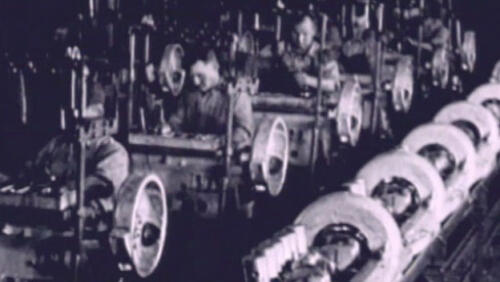Industrial Revolution
The Industrial Revolution began in the 18th century, when agricultural societies became more industrialized and urban. The transcontinental railroad, the cotton gin, electricity and other inventions from this era permanently changed society.
Featured Overview
Beginning in the 19th century, advances in manufacturing revolutionize the American way of life.
2:33m watch

Welgos/Getty Images
Featured Overview
Beginning in the 19th century, advances in manufacturing revolutionize the American way of life.
2:33m watch
Start Here

From water-powered textile mills, to mechanical looms, much of the machinery that powered America's early industrial success was "borrowed" from Europe.

The rise of mills and factories drew an influx of people to cities—and placed new demand on urban infrastructures.

While the Industrial Revolution generated new opportunities and economic growth, it also introduced pollution and acute hardships for workers.

Uprisings against a new economic structure imposed by the Industrial Revolution gave rise to the insult "luddite."
Child Labor
Sound Smart: Child Labor During the Industrial Revolution
Historian Yohuru Williams gives a rundown of important facts on child labor in the time of the Industrial Revolution.
1:56 watch

3 Inventions That Fueled the Industrial Revolution
Explore All Related Topics

Evidence of warming temperatures have been detected as early as the 1830s.

Since World's Fairs began in the 19th century, they have provided a stage to showcase new inventions and technologies, some of which became integral to daily life.

As England and the United States transformed under the Industrial Revolution, World Fairs served to drum up support for the shift.

The rise of mills and factories drew an influx of people to cities—and placed new demand on urban infrastructures.

While the Industrial Revolution generated new opportunities and economic growth, it also introduced pollution and acute hardships for workers.

The period between the late 1800s and the early 1900s saw a boom in innovations that would take the world by storm.

An 1830 battle between steam and horse power marked the moment when the Industrial Revolution changed transportation forever.

Over a 75-year period, up to 200,000 indigent children went from city to farm.

The rapid advancement of mass production and transportation made life a lot faster.

Uprisings against a new economic structure imposed by the Industrial Revolution gave rise to the insult "luddite."

In 1900, 18 percent of all American workers were under the age of 16.
Did summer camp save kids from factories? Learn about the unlikely history behind modern summer camps.
2:16m watch
Historian Yohuru Williams gives a rundown of important facts on child labor in the time of the Industrial Revolution.
1:56m watch

“Luddite” is now a blanket term used to describe people who dislike new technology, but its origins date back to an early 19th-century labor movement that railed against mechanized manufacturing.

The first modern flushable toilet was described in 1596 by a godson of Queen Elizabeth I.
In 1869 the Union Pacific and Central Pacific railroads converged at Promontory Summit, Utah, completing the Transcontinental Railroad.
4:20m watch
In 1838, U.S. Mint branches were opened across the country to fulfill the need for a centralized system of monetary exchange.
3:38m watch
Beginning in the 19th century, advances in manufacturing revolutionize the American way of life.
2:33m watch
In a Mail Call video, R. Lee Ermey answers a question from Carson a nine-year old boy from Colorado who asks when the Colt 45 started its service in the United States military and when it ended its career. The Colt 45 was invented by gun designer John Browning and made by the Colt firearm company and is one of the most famous military handguns of all time. The M-1911 had its official birthday on 1911 when the government was looking for a reliable man-stopper to replace the wimpy 38 caliber pistols that were in service. The Colt 45 became the weapon of choice for the U.S. Army, Navy, and the Marine Corps. In 1924, the 1911 was modified slightly and re-designated the 1911-A1. In 1983, the 45 automatic was retired after 72 years of loyal service.
1:49m watch

The 19th century was a period of great change and rapid industrialization. The iron and steel industry spawned new construction materials, the railroads connected the country and the discovery of oil provided a new source of fuel. The discovery of the S...

The Industrial Revolution of the 1800s, a time of great growth in technologies and inventions, transformed rural societies into industrialized, urban ones.

The Homestead strike was an industrial lockout and strike at the Homestead steel mill in Pennsylvania. The strike, which began on July 1, 1892, pitted one of the most powerful new corporations, Carnegie Steel Company, against the nation’s strongest trade union, the Amalgamated Association of Iron and Steel Workers. It culminated in a battle between workers and private security agents on July 6, 1892.

Child labor, the use of children and teens in often-unsafe working conditions, peaked during the Industrial Revolution but is now regulated by child labor laws.








